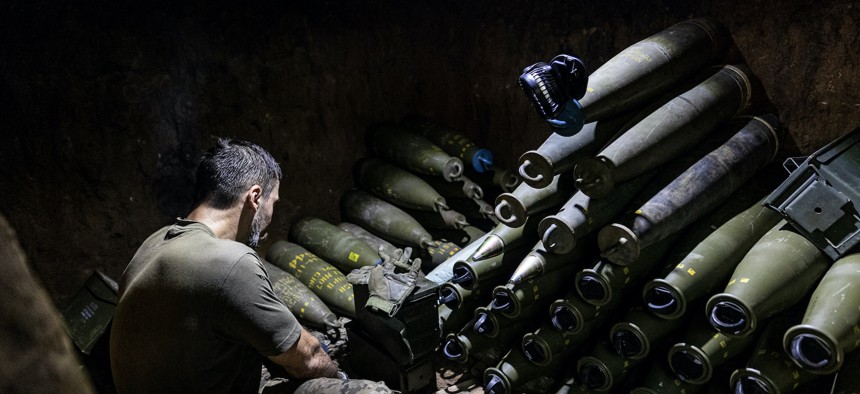
A Ukrainian soldier prepares 155mm artillery shells in his fighting position in Donetsk Oblast, Ukraine on August 6, 2023. Diego Herrera Carcedo / Anadolu Agency via Getty Images
Ukraine’s artillery supply declines as shells go to Israel
President Zelenskyy confirms that 155mm deliveries are drying up, even as Russia presses an assault in the east.
Ukraine has seen a decline of deliveries of vital 155mm shells since the start of the Israel-Hamas war, even as Ukrainian parliamentarians warn of a dangerous shortage of ammunition across the front lines.
"Our supplies have decreased. It is life—and it is normal, as everyone is fighting for survival,” Ukrainian President Volodymyr Zelenskyy told reporters in Kyiv on Thursday.
U.S. stocks of 155mm rounds that were originally meant for Ukraine are now being shipped to Israel, Axios has reported. The number of rounds were in the “tens of thousands,” according to the report, or close to U.S. monthly production rates.
The U.S. has delivered over two million 155mm rounds to Ukraine in the year and eight months since Russia’s February 2022 invasion. It has more than doubled production of the shells, going from 12,000 a month before Russia’s invasion to 28,000 now. EU members likewise emptied their stocks, and the EU as a whole launched a plan to supply one million 155mm rounds between March 2023 and March 2024.
Despite the effort, though, ammunition has frequently been tight. Ukraine uses 240,000 shells a month, a figure far higher than U.S. monthly production rates. Ukrainian troops regularly report ammo shortages across the front lines, even in hotspots like the country’s east.
The EU is also set to miss its March 2024 goal to supply one million rounds, German Defence Minister Boris Pistorius said this week.
Zelensky’s news of a reduction in U.S. deliveries, meanwhile, comes at a particularly challenging moment for Ukraine as Russia steps up its assaults near Avdiivka, a eastern-Ukrainian city where intense fighting resembles that seen in Bakhmut last winter.
“The situation is quite difficult,” said Ukrainian parliamentarian Yehor Cherniev. “The intensity of heavy shelling from our side is lower and lower because of the lack of ammunition,”
The war in Gaza is not the only thing slowing the delivery of arms to Ukraine. The funding pool approved by Congress for Ukraine aid is nearly empty.
The U.S. supports Ukraine primarily through supplemental funding appropriations. These funds are split into the Presidential Drawdown Authority (PDA), which pays to replace weapons sent from U.S. storehouses to Ukraine, and the Ukraine Security Assistance Initiative (USAI), which buys brand-new weapons.
USAI exhausted its funds in mid-October, while PDA had just $1.6 billion in uncommitted funds remaining. Defense leaders have pressed Congress to approve more, but at least some lawmakers doubt much will be done amid the debate about what to do after the latest temporary federal-spending resolution expires early next year.
Meanwhile, Ukraine must bear up against Russian assaults.
“I go to the front lines often,” said Oleksandra Ustinova, who leads the Holos party faction in the Ukrainian parliment. “I’m afraid to even go there because people literally don’t have anything to shoot with.”


